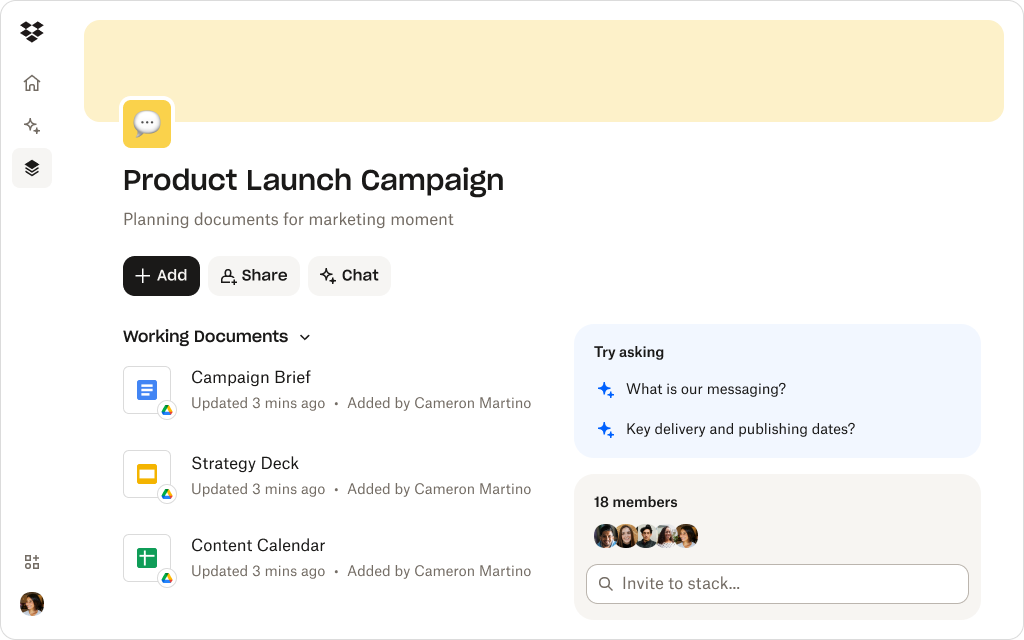
Small teams can’t afford delays—so how do you spot or clear workflow bottlenecks?
Every marketer or creative team member knows that moment when a campaign grinds to a halt. Here are a few common signs of things going wrong:
- Deadlines slip
- Feedback loops expand
- No one can find the latest version of the deck
For small teams, even a single stall can throw an entire launch off course—so you need to identify and clear bottlenecks fast.
These bottlenecks aren’t always dramatic. Delays often build quietly through things like scattered tools, delayed approvals, and missed messages. Over time, they drain creative momentum and stretch already thin resources.
Think of it like grains of sand slowly accumulating to create a bottleneck, instead of a boulder blocking your path.
Luckily, most bottlenecks can be fixed once you know where to look. By identifying where workflows break down—and using smarter tools to bridge the gaps—small teams can keep their campaigns flowing from idea to launch.

What workflow bottlenecks look like for small teams
When a campaign hits a stall point, it’s often one of the following issues:
- Waiting on approvals
- Hunting for missing assets
- Chasing version updates
What seems like a tiny thing can accumulate, like grains of sand, into a bigger issue—that means the entire timeline slips. For small teams, even one delay can cascade into missed launch windows or duplicated work.
A workflow bottleneck happens when one step in the process moves more slowly than the rest—impacting a subsequent step. For marketing and creative teams, this often looks like:
- Slow approvals—in turn holding back design or copy work
- File access issues—making communication between tools or drives difficult—or non-existent
- Feedback buried in multiple threads—preventing actions from moving forward
- Manual updates that break version control—causing painstaking rework or a need to roll back updates
These problems present logistical problems in the moment—but they cost momentum, morale, and opportunity when projects reach crunch time. Maybe you’re saying, “But we’re a small team! How can we face such difficulty?”
Sadly, small teams are affected just as much as large ones.
Why campaign delays happen more often in lean organizations
Small teams may move fast—but they often don’t have the infrastructure of larger ones. That means the same few people handle ideation, design, production, and sign-off. When one person is blocked, the whole workflow stops.
In practice, delays and bottlenecks in small marketing teams often trace back to three points:
- Fragmented tools—work is scattered across drives, chats, and project boards, making information retrieval slow
- Opaque approvals—everyone assumes someone else has reviewed or shared the file, so it sits gathering dust
- Unclear processes—without a defined workflow, responsibilities blur and progress stalls
- Revision loops—multiple versions circulate simultaneously, creating confusion and rework
When these inefficiencies stack up, the team spends more time coordinating than creating. Project quality can dip as a result, and your talented marketing team just wants to get on with their work—but can’t clear a bottleneck.
The hidden costs of repeated stalls
Every delay compounds. Missed publishing windows reduce campaign reach, late assets compress creative review time, and teams burn hours resolving version mismatches.
Annoyances in the moment are one thing, but here’s how those small stalls start to add up in a business sense:
- Momentum fades—projects lose urgency when waiting becomes the norm
- Context slips—by the time feedback arrives, the team’s focus has already shifted
- Morale dips—constant bottlenecks turn motivated teams into frustrated ones
- Opportunities vanish—delays can push launches past peak engagement windows
- Costs climb—time spent redoing or re-finding work quietly drains budgets and bandwidth
According to a survey by Gartner, 47% of digital workers have trouble finding the information they need to do their jobs well—a reminder that even small inefficiencies in information access can ripple through entire workflows.
For small marketing teams, the cost isn’t just time—it’s lost visibility and team energy. Bottlenecks break flow, and flow is where creative progress happens.
How to identify where your team is getting stuck
Every team hits slow spots—it’s part of creative work.
However, when those bottlenecks turn into patterns, they quietly drain time, energy, and morale. The hardest part is spotting them early. Before you can optimize, you need to see where progress stalls and why.
You can’t fix what you can’t see. Start by mapping the full campaign lifecycle—from kickoff to launch—and noting where tasks tend to pile up or require manual follow-up.
Look for signs such as:
- Repeated “Where’s that file?” messages—if you’re asking, you’ve already lost time
- Frequent file re-uploads or duplicated drafts—rework is the clearest symptom of disorganization
- Extended wait times for approvals or feedback—slow reviews often signal missing context, not effort
- Multiple tools needed just to locate a single update—when switching apps takes longer than acting on the information, it’s a workflow issue
Once identified, rank bottlenecks by impact. Determine which issues delay launches, cause confusion, or drain focus. Solving even one high-impact issue can restore flow across the team.
The AI-powered features in tools like Dropbox Dash help make those friction points visible—and fixable—by connecting people, content, and context in one workspace where nothing gets lost in the shuffle.
Strategies to keep campaigns moving smoothly
Marketing campaigns run on momentum. When it’s going right, it’s a buzz—and you can’t wait for the next stage.
However, when progress stalls because of unclear ownership, scattered tools, or lost feedback, the whole team feels the drag. But smooth, repeatable workflows don’t require huge teams or complex systems.
Here are a few ways to develop the right structure and instill a few smart habits in small teams.
- Standardize how work moves through stages: Define who approves what—and when. A simple, shared checklist prevents overlaps and guesswork. When roles are clear, work moves faster and feedback lands where it should.
- Reduce tool sprawl: Consolidate creative assets, feedback, and documentation into one workspace to eliminate switching costs. Every extra platform adds friction, while one connected space enhances focus.
- Automate progress signals: Automated notifications or summaries keep the team informed without extra meetings. Visibility keeps momentum alive—even when workloads are high.
- Capture context as you go: Use consistent naming and file organization so anyone can pick up where someone else left off. Good organization turns handoffs into seamless transitions, not slowdowns.
When structure meets clarity, small teams can operate with the precision of much larger ones. Dash brings that clarity to life—connecting tools and surfacing context automatically so campaigns stay in sync.

How Dropbox Dash helps teams clear workflow bottlenecks
Even the most talented teams slow down when their tools don’t talk to each other. Hours get lost searching for the right file or trying to piece together updates spread across apps. It’s a problem caused by a clear lack of visibility.
Dash is built for teams that need to move fast and stay organized without adding tools or complexity. Here’s how it does that for marketing teams and many other organizations:
Universal search
Universal search capabilities in Dash helps teams to find content across Dropbox, Google Drive, Slack, and other connected apps in seconds. Instead of toggling between tools, teams can locate the exact file or message they need—instantly. The result is fewer clicks, faster answers, and uninterrupted focus.
Chat and summaries
Dash Chat turns long feedback threads into concise summaries and quick answers, reducing back-and-forth and helping teams align on next steps. It keeps conversations productive by distilling noise into clarity. Got a huge document you don’t know where to start with? Just ask for a summary and get the key points in seconds.
Stacks for campaign assets
Teams can group creative assets, messaging docs, and deliverables into a single Stack—so everyone works from one source of truth. Updates sync automatically, so the most current file is always visible. When you use Stacks, collaboration becomes effortless because context is built in.
In short, Dash removes the bottlenecks that come from searching, switching, and second-guessing. It gives small teams back the time they need to execute great work.
Clear bottlenecks and move campaigns forward
Stacks make it easy to organize, view, and manage all your important campaign content—so your team never stalls waiting for context.
Best practices to prevent future stalls
Efficient teams study bottlenecks, fix them, and make sure they don’t happen again. By turning everyday friction into insight, small teams can build the kind of momentum that scales and pivots from one campaign to the next.
Here’s how to keep your workflows moving and improving:
- Build retrospectives into your process—review what caused the last delay before launching the next campaign
- Set file governance rules—decide who owns each stage of approval and where files live
- Use automation thoughtfully—AI tools like Dash Chat and summaries should clarify, not clutter, your process
- Document what works—save successful workflows as templates to speed up future projects
Small teams thrive when knowledge is shared, not siloed. Dash makes that easy—connecting your tools, assets, conversations, and context in one intelligent workspace, so every lesson learned becomes fuel for the next success.
Keeping momentum as your team scales
As your campaigns grow, so will the number of assets, contributors, and feedback loops. Scaling smoothly means extending your early discipline. Here’s what that looks like in practice:
- More people, same clarity—growth doesn’t have to mean confusion, so make sure that roles stay defined and ownership stays clear
- More assets, less chaos—with Dash Stacks files, decks, and visuals all live in one connected workspace, not scattered across drives
- More channels, one voice—by using Dash Chat, consistent messaging and creative alignment stay intact no matter where content appears, which means you can scale with ease
- More automation, fewer headaches—the combination AI-powered features means Dash can handle the busywork, so teams can stay focused on strategy and storytelling
With Dash, those guardrails are built in. Its features scale naturally with your workload, so every new campaign starts clear, current, and connected.
Keep campaigns flowing with Dropbox Dash
Great campaigns depend on momentum, not meetings. Dash helps small teams find what they need, stay aligned, and launch faster—with fewer bottlenecks along the way.
See how Dash helps teams plan, execute, and deliver campaigns more efficiently—no matter how big your team or ambitions grow. See it for yourself, try a demo or contact sales to get started today.
Frequently asked questions
Bottlenecks happen when one part of a campaign moves more slowly than the rest—often due to scattered tools, unclear ownership, or waiting on approvals.
Dash unifies files, assets, and conversations into one searchable workspace. Teams can instantly find what they need, summarize feedback, and share updates securely—all without switching tools.
Unlike single-function apps, Dash combines AI search, smart organization, and secure sharing inside one intuitive workspace. It fits how small teams already work, not the other way around.

.svg)

